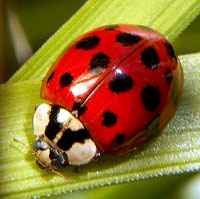
The problem is there are too foreigners in this country. Those Asians, they come here and eat all our insects, without so much as with your leave or by your leave. The Harlequin ladybird (Harmonia axyridis) is putting over 1,000 species in the UK in peril, scientists have warned. Originally from Asia, the harlequin preys on a wide variety of insects, including the larvae of other ladybirds, and will also eat fruit.
Introduced in continental Europe to control pest insects and first "spotted" (geddit?) in Essex in 2004, the ladybird has spread to most parts of the UK in only four years, preying on many other insects. "The rate of spread is dramatic and unprecedented," says Dr Helen Roy of the Centre for Ecology and Hydrology.
And they breed like crazy. Native ladybird species produce just one generation per year, but the Harlequin has as many as five generations per year. So we know how to deal with these interlopers: kick'em in the goolies. One likely predator to control the immigrants is a sexually transmitted mite that renders female ladybirds infertile, and is passed from one generation to the next by inter-generational mating.
Since the natives mate only once a year the mite is unable to propagate between generations of British ladybirds, but since the Harlequins are at it all the time, their very own sexually transmitted parasite will keep down their numbers.
No comments:
Post a Comment